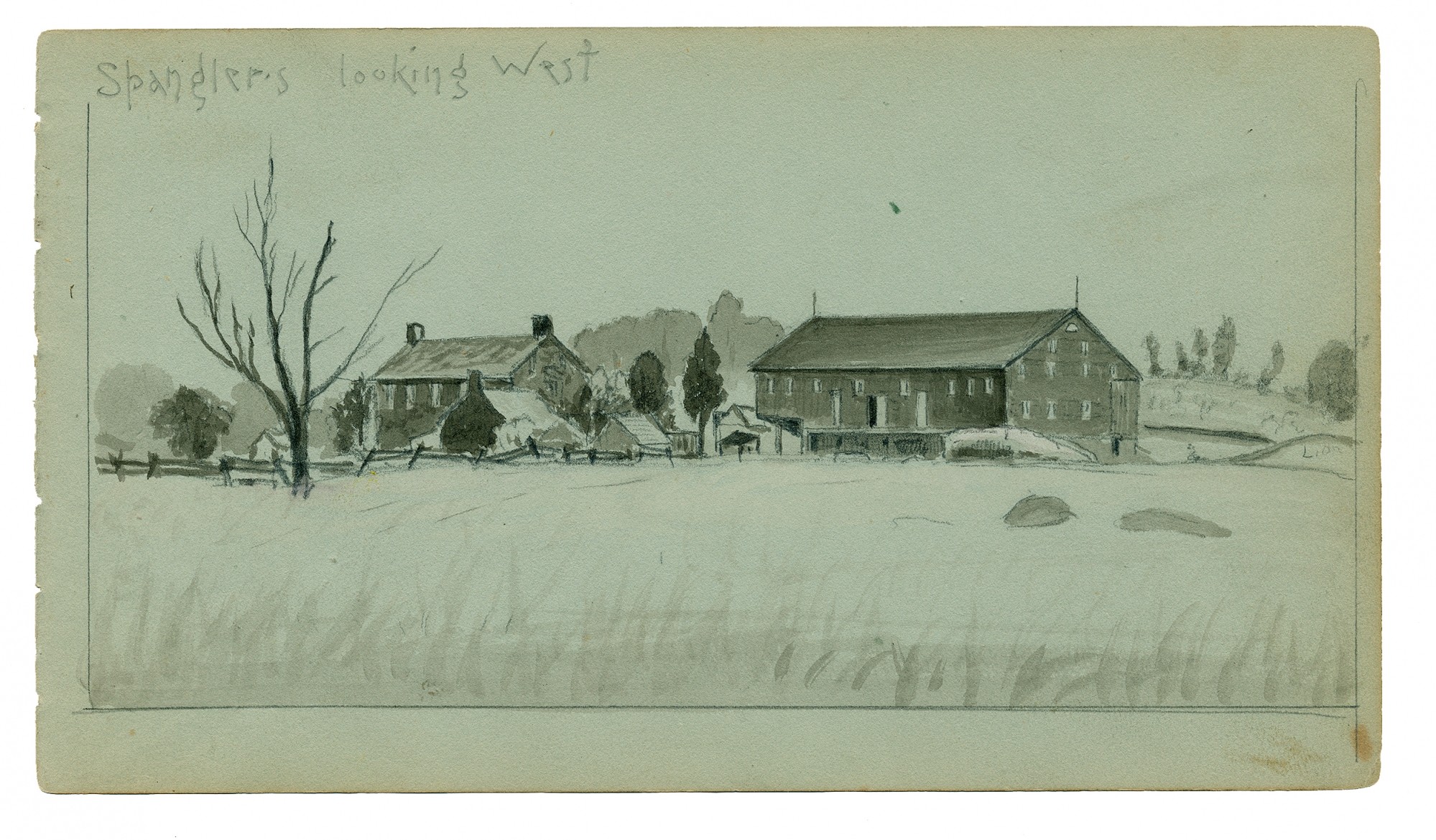site search
online catalog
GETTYSBURG SKETCH OF THE SPANGLER FARM BY 9TH MASS BATTERY VETERAN & ARTIST RICHARD HOLLAND

$950.00 SOLD
Quantity Available: None
Item Code: 955-46
This full page black and white sketch was done from a point on Blacksmith Shop Road looking west toward the Spangler farm. Sketch meas. approx. 7.75 x 4.50 inches.
The foreground is taken up by the open field that lies between the Blacksmith Shop Road and the farm buildings. At the middle left is the worm fence which runs along the lane leading up to the house and barn. The main house is visible at left while the barn dominates the right middle distance. Clearly seen in front of the house is the summer kitchen with chimney where Confederate General Lewis Armistead was taken after being wounded in Pickett’s charge on July 3rd. It was here that he died. Several other small outbuildings are seen between the house and barn.
Sketch is very well done with defined details.
Top left corner of the sketch bears the title “SPANGLERS – LOOKING WEST.”
This sketch was executed by Richard Holland when he returned to Gettysburg as a part of the 9th Massachusetts Battery Monument Committee in 1884.
Included with sketch is a facsimile copy of the front inside cover of the sketchbook to which is glued three newspaper articles regarding the 9th Massachusetts Battery monument at Gettysburg.
Richard Holland was born to Michael and Joanna Holland in Ireland on March 15, 1842. He came to the United States with his family at age 12 and settled in North Bridgewater, Massachusetts. Eventually Holland became an apprentice to Captain Lucius Richmond and learned the trade of a painter in which profession he was engaged when the Civil War began.
The now 21 year old Holland enlisted in the office of the selectman of North Bridgewater on July 29, 1862 and was assigned to the 9th Massachusetts Light Battery. At the time of his enlistment Holland was described as being 5’ 6 ½” tall with blue eyes, black hair and a dark complexion.
The 9th Massachusetts Battery served with the 5th and 9th Corps of the Army of the Potomac. Private Holland served as the #4 crewman on a gun in the left section of the battery and was responsible for priming and firing the gun on command. He was present with the battery throughout its service being engaged at Gettysburg, Mine Run, the Wilderness, Spotsylvania, Bethesda Church, Totopotomoy, Petersburg, Weldon Railroad, Hatcher’s Run and the pursuit of Lee. The batteries heaviest loss occurred at Gettysburg where they were very heavily engaged on July 2nd on the Trostle farm. During that action they lost 8 men killed, 19 wounded and 1 missing. Holland was mustered out at the close of the war on June 6, 1865 and brought home with him a sketchbook in which he had kept drawings of people and places related to his service.
He was married twice. The first time to Miss Cecilia Pray in May of 1866. Sadly she died at age 36 of heart disease in April of 1880. The couple had two children, Charles born August 9, 1870 and Mary Cecilia born October 3, 1872. Mr. Holland married for the second time on July 1, 1882 to Marietta M. Monk. The couple had no children.
After the war Holland resumed his trade as a painter. He became known for his skill graining and later in frescos. His paintings were found in churches throughout the area of his hometown as well as in the Brockton City Hall in Brockton, Massachusetts. His work in the town hall was considered “handsome and spirited.” The frescos depict the battle between the USS KEARSARGE and the CSS ALABAMA, Fort Sumter, the Monitor and the Merrimack, the 12th Massachusetts Battery going into action at Antietam, a Union drummer boy and a mounted cavalry scouting party led by his former employer Lucius Richmond.
Aside from the Brockton Town Hall, Holland also became known for smaller canvas paintings of still life, landscapes etc... However he avoided portraiture in which he felt he did not excel.
In 1884 he returned to Gettysburg as part of a commission to look into the placement of a memorial to the 9th Massachusetts Battery. While there he added to his wartime sketchbook numerous views of the Gettysburg battlefield.
Holland was a member of the Fletcher Webster Post #13 of the GAR and Appomattox Regiment of the Union Veteran’s Union. He was known for lending his artistic talents to any organization he was a member of and without payment.
When he died of pneumonia on January 12, 1906 he was remembered as a helpful, modest, unassuming and kind person. He is buried in Union Cemetery in Brockton, Massachusetts.
Holland’s military records accompany this item. [ad]
~~~~~~~~~~~~~~~~~~~~~~~~~~~~~~~~~~~
THIS ITEM, AS WITH ALL OTHER ITEMS AVAILABLE ON OUR WEB SITE,
MAY BE PURCHASED THROUGH OUR LAYAWAY PROGRAM.
FOR OUR POLICIES AND TERMS,
CLICK ON ‘CONTACT US’ AT THE TOP OF ANY PAGE ON THE SITE,
THEN ON ‘LAYAWAY POLICY’.
Inquire About GETTYSBURG SKETCH OF THE SPANGLER FARM BY 9TH MASS BATTERY VETERAN & ARTIST RICHARD HOLLAND
For inquiries, please email us at [email protected]
Most Popular
Historical Firearms Stolen From The National Civil War Museum In Harrisburg, Pa »
Theft From Gravesite Of Gen. John Reynolds »
Cavalry Carbine Sling Swivel »
Fine Condition Brass Infantry Bugle Insignia »
featured item
EARLY WAR U.S. CAVALRY OFFICER’S SABER, 1840 STYLE, BY SMITH, CRANE AND COMPANY, NEW YORK, 1858 TO 1862
Smith, Crane and Company pieces are scarce. They were only in business from 1858 through 1862, retailing military goods in New York City. Their swords were imported, of German make and likely by Schnitzler and Kirschbaum, though not maker marked.… (870-263). Learn More »




